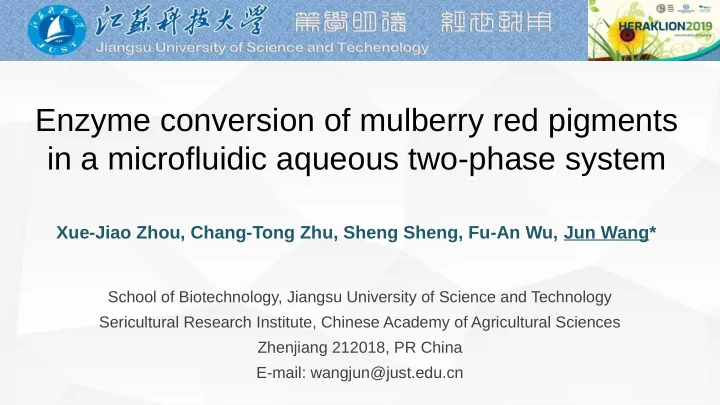

Enzyme conversion of mulberry red pigments in a microfluidic aqueous two-phase system Xue-Jiao Zhou, Chang-Tong Zhu, Sheng Sheng, Fu-An Wu, Jun Wang* School of Biotechnology, Jiangsu University of Science and Technology Sericultural Research Institute, Chinese Academy of Agricultural Sciences Zhenjiang 212018, PR China E-mail: wangjun@just.edu.cn
CONTNET Introduction Methods Results Conclusions Acknowledgments
Introduction 01 Mulberry red pigment--natural edible pigment 90% 30% 60% Fresh mulberry Rotten mulberry 3 [1] Song H, et al. Nutrition Research, 2016, 36(7):710-718.
Methods 02 Aqueous two-phase enzyme catalysis system Extraction, catalysis, separation Disadvantages: Long separation time Easily emulsification Microfluidic 4 [2] Krause J, et al. Journal of Chromatography A, 2015, 1391(1):72-79.
02 Methods Microfluidic aqueous two-phase enzyme catalysis system 500 times higher than enzymatic rate in conventional reactor 5 [3] Meng S X, et al. Chemical Engineering Journal, 2017, 335.
Results 8.4 s 03 HPLC-PDA-ESI-MS ℃ 45 pH 5 45 ℃ , 8 + h α -L-rhamnosidase MWCNTs IE Fig. 1 Diagram of microfluidic aqueous two-phase device. 6
Results 03 Film Expo Develop making -suring -ment Etching Punching Bonding Fig.2 Design and manufacture of double Y-branched microfluidic chip. (a) Design figure of double Y-type microfluidic chip; (b) Real figure of double Y-branched microfluidic chip. The middle main channel is 3.5 cm length and 600 μ m width The double Y-branch is 7 mm length and 300 μ m width 7
Results 03 Inlet A Ammonium sulfate chip microscope Longer pump Inlet B Ethanol column oven Fig. 3 Physical diagram of microfluidic aqueous two-phase device. 8
Results 03 dvρ Re = 18% Ethanol and Rhodamine B μ 11.5 µ L/min 27% Ammonium sulfate and Re < 2000 malachite green parallel flow formation 15.5 µ L/min Tab. 1 Calculation of Re in microchannel. Width Flow rate Density Viscosity Substance Re ( µ m ( µ L/min ( kg/m 3 ( Pa·s ) Fig. 4 Photograph of ATPS in ) ) ) microchannel under microscope. Ethanol 900 11.5 7.89×10 2 1.074×10 -3 1.11×10 -3 Ammonium 900 15.5 1.42×10 3 2×10 -3 1.48×10 -3 sulfate 9
Results 03 Fig. 5 HPLC–PDA-MS/MS of the product in microfluidic aqueous two-phase enzyme catalytic system. (a) HPLC chromatograms of mulberry red pigment; (b) Mass chromatogram of C 3 G; (c) Mass chromatogram of C 3 R. Tab. 2 HPLC-PDA-ESI-MS data of mulberry red pigment. Peak Rt (min) [M] + (m/z) λ max (nm) Content 1 8.40 449 280,513 C 3 G 2 10.21 595 280,513 C 3 R 10 [4] Diaconeasa Z, et al. Plant Foods for Human Nutrition, 72(4), 404-410 (2017).
pH 5 Substrate concentration 0.008 mg/mL Temperature 45 ℃ C 3 R Conversion 70.29% C 3 G Content 70.76% C 3 R Conversion 81.66% C 3 G Content 80.78% C 3 R Conversion 61.29% C 3 G Content 74.69% Tab. 3 Residence time of the fluid in microchannel at different Tab. 4 The fluid residence time in microchannel at ethanol different ammonium sulfate flow rates when ethanol flow rate at 11 μ L/min. flow rates when ammonium sulfate flow rate fixed at 14.5 μ L/min. Ethanol flow Ammonium sulfate Residence Ethanol flow Ammonium Residence rate ( µ L/min) flow rate ( µ L/min) time τ (s) rate ( µ L/min) sulfate flow rate time τ (s) ( µ L/min) 8.00 14.50 10.50 8.50 14.50 10.12 11.00 13.50 10.50 9.00 14.50 9.77 11.00 14.00 10.12 11.00 14.50 9.77 10.00 14.50 8.59 11.00 14.50 8.33 11.00 16.00 8.86 11.50 14.50 8.10 11.00 16.50 8.59 12.00 14.50 7.88 11.00 17.00 8.33 12.50 14.50 7.46 11.00 17.50 8.10 11.00 18.00 7.88 Ethanol flow rate 10 μ L/min Ammonium sulfate flow rate 14.5 μ L/min C 3 R Conversion 53.78% C 3 G Content 64.48% C 3 R Conversion 39.98% C 3 G Content 60.29% Fig. 6 Effect of conditionsons on C 3 R conversion rate and C 3 G content. 11
Results 03 Immobilized enzyme can be reused 7 times Relative enzyme activity is higher than 60% Fig. 7 Reuse of immobilized enzyme. 12
Results 03 C f[A ] = + K In(1- f) 0 m Q Tab. 5 Different Km of ethanol flow rates when ammonium sulfate flow rate fixed at 14.5 μ L/min Ethanol flow rate Km ( μ L/min ) ( μ M) 12 242.53 8 226.14 10 195.39 Fig. 8 Lilly-Hornby plots for immobilized enzyme in photopatterned microchannel. 13
Conclusion 04 1 The size of double Y-branched microfluidic chips: middle main channel: 35 mm×0.6 mm × 0.15 mm, double Y-branch: 7 mm×0.3 mm×0.15 mm. Under the optimal conditions of ammonium sulfate flow rate of 14.50 2 μ L/min , ethanol flow rate of 10 μ L/min , pH 5 , temperature 45 ℃ and substrate concentration of 0.008 mg/mL , the conversion of C 3 R and the content of C 3 G were 82% and 81% , respectively. 3 The immobilized enzyme could be reused 7 times, the relative enzyme activity was stabilized at more than 60% and the C 3 R conversion rate was maintained at more than 50%. 4 When the ethanol fmow rate was 10 μ L/min , the Km value was the lowest and the enzyme and substrate concentration had the highest affjnity. 14
Acknowledgement 05 1 Key Research and Key Project of University Development Program (Modern 2 Science Research of Jiangsu Agriculture) of Zhenjiang City Province(16KJA530002) (NY2017010) 3 Natural Science Foundation Qing Lan Project of Jiangsu 4 of China (21676130) Province (Year of 2014) Shen Lan Young scholars program 5 of Jiangsu University of Science and Technology (Year of 2015)
Thanks for listening
Recommend
More recommend